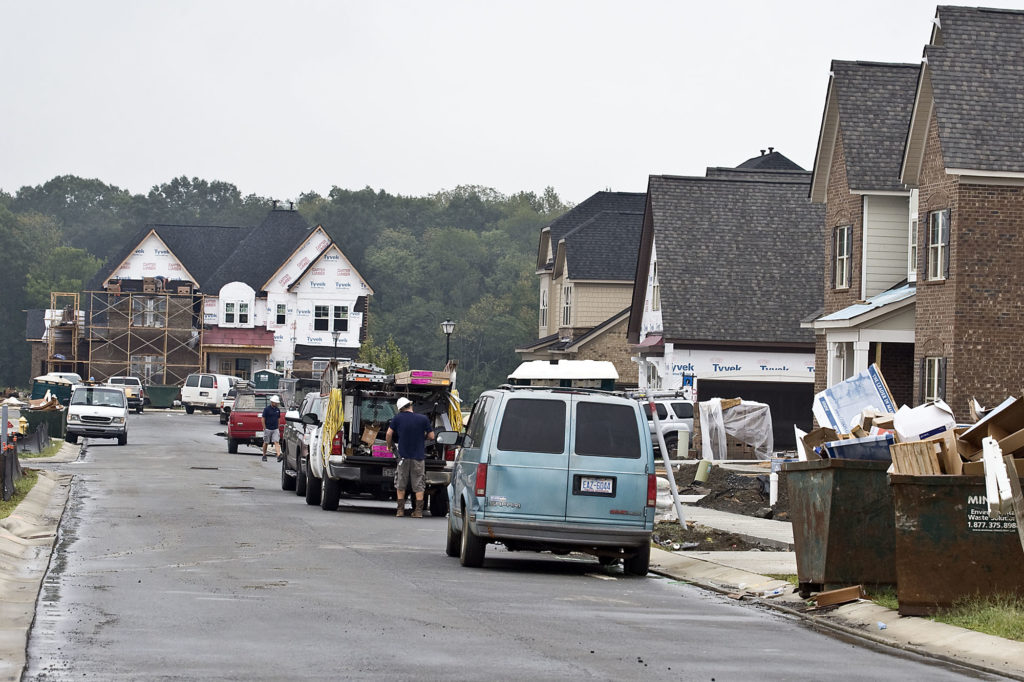
Photo by Marty Price
By Erica Batten. A “tidal wave” of rising home values is pricing housing out of reach for a wide range of ordinary people—everyone from musicians to teachers to firefighters. Case-Schiller says Charlotte single-family home prices rose 6 percent over the past year. Some neighborhoods are considerably higher, but the homes that rank and file workers want to live in are getting pricier by the day.
Then, too, median rent nationwide is accelerating at its fastest annual pace in 21 months, climbing 2.8 percent year-over-year to $1,445 in February, according to Zillow. All this is happening as the amount of undeveloped land continues to shrink, potentially squeezing out the people who make the wheels of the local economy turn.

Grant
“It’s hard to control the tidal wave of rising land values,” Andrew Grant, Cornelius’ assistant town manager said at a Business Today Newsmakers Breakfast in March.
Site selection consultants say major employers eyeballing a community look at the workforce and the prospect of recruiting employees. Seattle and Denver have created public-private partnerships to provide low-cost loans for affordable housing near public transit.
Chris Ahearn, the new executive director of Our Towns Habitat for Humanity, said building home equity fosters a sense of stability and builds community.
Officials in Charlotte, where rioting broke out after the Keith Lamont Scott shooting in 2016, say they missed an important opportunity to incorporate affordable housing into the South End.
Panelists also included Jim Burbank of Charlotte-based homebuilder Saussy Burbank and John Quinn of the Smithville Community Coalition in Cornelius. Difficult subjects under the heading of Workforce Housing include the definition of “affordable,” as well as how to financially support the development of workforce housing and how to implement it.
A common measure defines home affordability as spending no more than 30 percent of gross income on housing, including utilities. This measure does not take into account other fixed expenses such as health care, transportation, childcare, nor does it include debt-to-income ratio.

Ahearn
Grant said the local government must conduct workforce studies to determine whether needs might be best met through single-family units, apartments, or some mix of those. Towns must also consider how population density will impact schools, traffic, emergency services and other infrastructure.
“That may invoke some changes in our land-use plan,” Grant said.
A 2014 study found that only 10 percent of Cornelius’ workforce lives in town.
Burbank called teachers, police and firefighters “the most invoked group” in the discussion about our workforce. The average income for Mecklenburg County teachers was $48,500 in 2015-16, according to CMS data. Glassdoor.com puts Charlotte-area police officers’ average yearly salary below $50,000.
The median home value in Concord is $179,700, according to Zillow. In Cornelius, it’s $288,000. The median price of homes currently listed in Cornelius is $410,950, well outside the bounds of affordability for a wide swath of working people.
Panelists said that planners should follow the example of other towns—like Charlottesville, Va.—that have successfully incorporated workforce housing into the local aesthetic.
Quinn said the historically black, “land-rich” Smithville community would benefit from mixed-income development that does not displace residents.

Burbank
The Town of Cornelius has already acquired several properties in Smithville because of unpaid taxes.
Just to the north, Davidson is one of three North Carolina towns—coastal Manteo and Chapel Hill are the others—with an affordable housing (also called “inclusionary zoning”) ordinance.
Enacted in 2001, the Davidson ordinance originally required that for every eight new housing units, one of them, or 12.5 percent, had to be affordable. Developers are allowed to pay a fee in lieu of housing, which goes into the town’s modest affordable housing fund. As of last year, 73 units had been built under Davidson’s affordable housing program.
And while Davidson’s program is aimed at easing the pressure of rising property prices, developers said they’ve had to personally subsidize the required affordable units, and that this burden will increase as land prices continue to rise.
There is no single solution because there are multiple problems, Burbank said.
“The key for me, from a private-sector viewpoint, is for public money to get in there early,” Burbank said. “Land is critical.”
Towns placing land in reserve for future development can help ease the burden of rapidly increasing property values on those seeking affordable housing. Saussy Burbank has obtained lots from the Town of Davidson for $1,000 each.

Quinn
In spite of such deals, the development that includes affordable housing is not a profitable business, said Burbank. “You give up more than you get. If you’re purely motivated by money, you’ll probably look to do something else.”
Joe Roy, the founder of Meeting Street Homes and Communities, a Cornelius-based developer, said affordability isn’t the only obstacle in building affordable housing.
“The qualifications to be able to build one of these developments are insurmountable,” Roy said. “Our zoning does not give a real incentive for those of us trying to be good stewards.”
Whether developers are helped by affordable housing incentives or not, towns might also reconsider whether municipal government planning of affordable housing is as crucial as we might think.
When Davidson conducted a survey of town employers as part of its 2017 Housing Needs Assessment, most said that it was not a priority to have their employees live in town because affordable housing is available in adjacent areas. Davidson’s lack of diversity deterred potential employees from seeking housing in town, particularly when commuting from Charlotte offers “more diverse lifestyle options.”
Diversity in Cornelius is comparable to Davidson. The 2010 census showed that 84.4% of the Cornelius population identifies as Caucasian; in Davidson, it’s 85.9%. The percentage of the population in Mecklenburg County identifying as white is 50.4%.
For those who qualify for affordable housing, deed restrictions keep homes affordable long-term but may make them ineligible for good mortgages and reduce their marketability. At the same time, the cost of market-rate units rises as developers are forced to pass along the cost of building affordable units.
Can affordable housing programs keep up with future demand? Millennials may follow previous generations into the suburbs as the desire for walkable neighborhoods and proximity to amenities is displaced by the desire for a bigger yard and, perhaps, lower taxes. A recent Urban Land Institute study suggested that demands on urban areas may be eased by such an exodus.
Despite the uncertainty surrounding affordable housing, panelists and attendees at the Newsmakers Breakfast wanted to see local government—perhaps regionally—address the issue.

Discussion
No comments yet.